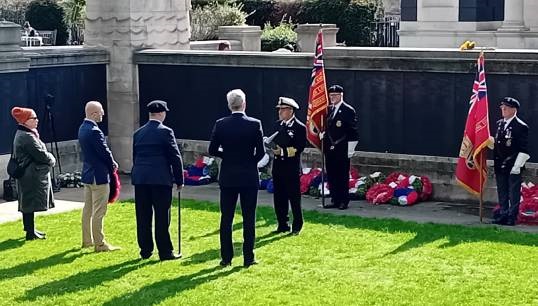
On 28 September 2024, the UK maritime community marked the 30th anniversary of the tragic sinking of the ferry Estonia in the Baltic Sea – one of the deadliest peacetime shipping disasters of the 20th century, with the loss of 852 lives.
In his role as president of the British Titanic Society, Nautilus member Captain Aseem Hashmi led a commemorative service at the Merchant Navy Memorial on Tower Hill in London.
He was joined by the Estonian ambassador to the UK, as well as representatives of Nautilus International, the Nautical Institute and the Merchant Navy Association.
Captain Hashmi gave a speech reflecting on the lives lost and lessons learnt from the incident, and wreaths were then laid in memory of the deceased crew and passengers.
Extracts from Capt Hashmi's speech are below:
We are gathered here in this tranquil Merchant Navy Memorial garden in London with the names of over 32,000 sailors lost at sea during the wars, but as a fellow Merchant Navy fraternity here today, we also mourn the loss of fellow sailors across the seven seas, as the sea is a thread that binds us all – including those who sadly lost their lives in the Baltic Sea on 28 September 1994.
…
The official investigation into the tragedy jointly conducted by Estonia, Finland and Sweden concluded that the locks on the bow door had failed from the strain of the waves and the door had separated from the rest of the vessel, pulling the inner loading ramp open and rendering the car deck calamitously exposed to the Baltic Sea. This in turn was put down to inherent design flaws being the major root cause.
…
Sadly, as in many cases, rules and procedures only change after some major incident or tragedy. Just as the Titanic tragedy gave impetus to the SOLAS regulations as we know them today, and the Herald of Free Enterprise was the catalyst inter alia for the inception of the ISM Code, the MS Estonia has also left its legacy with the horrendous 86% fatality cost.
The MS Estonia tragedy taught us many valuable lessons with respect to human behaviour and interactions in emergencies. Since 1999 it has been a requirement for all crew on passenger ships to now undergo Crowd and Crisis Management and Human Behaviour Training.
Another legacy from the MS Estonia's sinking was that, until that tragedy, EPIRB distress beacons only required manual activation. However, since the incident, EPIRBs now should be activated automatically – and had this been in place in 1994, Estonia's position would have been known much faster. This also was instrumental for the subsequent introduction of Voyage Data Recorders onboard vessels. Further IMO and SOLAS requirements for rescue criteria from listing ships in rough water were introduced, as well as ferry car deck flooding and stability regulations.
…
Whilst the pain of loss and grief for the families and loved ones of the 852 victims will endure, their suffering and loss was not totally in vain.
Tags
More articles
Joint Consultative Committee meetings between Nautilus and CalMac
At the JCC meeting on 13 September 2024, discussions covered a wide range of topics relevant to members including: the CHFS3 contract
World Maritime Day 2024 marks 50 years of the SOLAS Convention
World Maritime Day on 26 September 2024 has the theme Navigating the future: safety first! But it also marks 50 years since the International Convention for the Safety of Life at Sea (SOLAS) was adopted.
Nautilus International welcomes government pledge to end unfair employment practices
Maritime minister Mike Kane has reiterated the government’s commitment to protect workers' rights and end the type of unfair employment practices seen at P&O Ferries, in a recent speech to maritime industry stakeholders at the Labour Party Conference in Liverpool.
